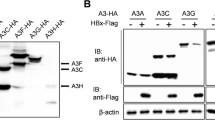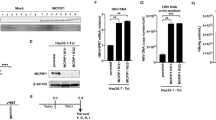Abstract
Hepatitis B virus (HBV) infection is a noteworthy cause of liver diseases, especially cirrhosis and hepatocellular carcinomas. However, the interaction between the host and HBV has not been fully elucidated. Peptide YY (PYY) is a 36-amino-acid gastrointestinal hormone that is mainly involved in the regulation of the human digestive system. This study found that PYY expression was reduced in HBV-expressing hepatocytes and HBV patients. Overexpression of PYY could significantly inhibit HBV RNA, DNA levels, and the secretion of HBsAg. In addition, PYY inhibits HBV RNA dependent on transcription through reducing the activities of CP/Enh I/II, SP1 and SP2. Meanwhile, PYY blocks HBV replication independent on core, polymerase protein and ε structure of pregenomic RNA. These results suggest that PYY can impair HBV replication by suppressing viral promoters/enhancers in hepatocytes. Our data shed light on a novel role for PYY as anti-HBV restriction factor.





Similar content being viewed by others
Data availability
The datasets supporting the conclusions of this article are available in the SRA (www.ncbi.nlm.nih.gov/sra) database.
References
Howell J, Pedrana A, Schroeder SE et al (2021) A global investment framework for the elimination of hepatitis B. J Hepatol 74(3):535–549
Vachon A, Osiowy C (2021) Novel biomarkers of hepatitis B virus and their use in chronic hepatitis B patient management. Viruses 13(6):951
Yan H, Zhong G, Xu G et al (2012) Sodium taurocholate cotransporting polypeptide is a functional receptor for human hepatitis B and D virus. eLife 1:e00049
Qi Y, Gao Z, Xu G et al (2016) DNA polymerase kappa is a key cellular factor for the formation of covalently closed circular DNA of hepatitis B virus. PLoS Pathog 12(10):e1005893
Moolla N, Kew M, Arbuthnot P (2002) Regulatory elements of hepatitis B virus transcription. J Viral Hepat 9(5):323–331
Tan G, Song H, Xu F et al (2018) When hepatitis B virus meets interferons. Front Microbiol 9:1611
Hu J, Seeger C (2015) Hepadnavirus genome replication and persistence. Cold Spring Harb Perspect Med 5(7):a021386
Liu N, Ji L, Maguire ML et al (2004) Cis-acting sequences that contribute to the synthesis of relaxed-circular DNA of human hepatitis B virus. J Virol 78(2):642–649
Di Domenico M, Pinto F, Quagliuolo L et al (2019) The role of oxidative stress and hormones in controlling obesity. Front Endocrinol (Lausanne) 10:540
Xu H, Ma Y, Zhang J et al (2020) Identification and verification of core genes in colorectal cancer. BioMed Res Int 2020:8082697
Larraufie P, Martin-Gallausiaux C, Lapaque N et al (2018) SCFAs strongly stimulate PYY production in human enteroendocrine cells. Sci Rep 8(1):74
McFadden DW, Riggs DR, Jackson BJ et al (2004) Peptide YY inhibits the growth of Barrett’s esophageal adenocarcinoma in vitro. Am J Surg 188(5):516–519
Alosi JA, McFadden DW (2009) Peptide YY mediates inhibition of tumor growth and inflammation. Methods Mol Biol 512:377–394
Leitch VD, Brassill MJ, Rahman S et al (2019) PYY is a negative regulator of bone mass and strength. Bone 127:427–435
Valentini L, Schuetz T, Omar A et al (2011) Abnormal plasma peptide YY(3–36) levels in patients with liver cirrhosis. Nutrition 27(9):880–884
Nishitsuji H, Ujino S, Shimizu Y et al (2015) Novel reporter system to monitor early stages of the hepatitis B virus life cycle. Cancer Sci 106(11):1616–1624
Que L, Liu G, Kitamura K et al (2017) Molecular characterization of AID-mediated reduction of hepatitis B virus transcripts. Virology 510:281–288
Cha MY, Ryu DK, Jung HS et al (2009) Stimulation of hepatitis B virus genome replication by HBx is linked to both nuclear and cytoplasmic HBx expression. J Gen Virol 90(Pt 4):978–986
Ko C, Lee S, Windisch MP et al (2014) DDX3 DEAD-box RNA helicase is a host factor that restricts hepatitis B virus replication at the transcriptional level. J Virol 88(23):13689–13698
Li X, Wang Z, Zhou W et al (2022) Interferon-alpha responsible EPN3 regulates hepatitis B virus replication. Front Med (Lausanne) 9:944489
Jiang W, Wang L, Zhang Y et al (2020) Circ-ATP5H induces hepatitis B virus replication and expression by regulating miR-138-5p/TNFAIP3 axis. Cancer Manag Res 12:11031–11040
Doitsh G, Shaul Y (2004) Enhancer I predominance in hepatitis B virus gene expression. Mol Cell Biol 24(4):1799–1808
Lai WS, Arvola RM, Goldstrohm AC et al (2019) Inhibiting transcription in cultured metazoan cells with actinomycin D to monitor mRNA turnover. Methods 155:77–87
Liang G, Liu G, Kitamura K et al (2015) TGF-beta suppression of HBV RNA through AID-dependent recruitment of an RNA exosome complex. PLoS Pathog 11(4):e1004780
Liu Y, Nie H, Mao R et al (2017) Interferon-inducible ribonuclease ISG20 inhibits hepatitis B virus replication through directly binding to the epsilon stem-loop structure of viral RNA. PLoS Pathog 13(4):e1006296
Xiao Y, Liu C, Tang W et al (2019) Evans blue inhibits HBV replication through a dual antiviral mechanism by targeting virus binding and capsid assembly. Front Microbiol 10:2638
Mitsui M, Nishikawa M, Zang L et al (2009) Effect of the content of unmethylated CpG dinucleotides in plasmid DNA on the sustainability of transgene expression. J Gene Med 11(5):435–443
Till H, Schlichting N, Oberbach A (2015) Tumor-associated energy homeostasis: hepatoblastoma and neuroblastoma affect glucose and lipid metabolism as well as ghrelin, GLP-1, and PYY in nude rats. Eur J Pediatr Surg 25(1):128–131
Sagnelli E, Potenza N, Onorato L et al (2018) Micro-RNAs in hepatitis B virus-related chronic liver diseases and hepatocellular carcinoma. World J Hepatol 10(9):558–570
Mao R, Nie H, Cai D et al (2013) Inhibition of hepatitis B virus replication by the host zinc finger antiviral protein. PLoS Pathog 9(7):e1003494
Funding
Sponsored by the Natural Science Foundation of Liaoning Province of China (2022-MS-409), Science and Technology Innovation Project of Shenyang (RC210215), Foundation of Liaoning Educational Committee (LJKQZ2021176) and the Innovation Fund of Shenyang medical college (Y20220508).
Author information
Authors and Affiliations
Contributions
XX, WZ, XL, CZ and YL: data acquisition. XX, WZ, XL, BY and YS: data analysis and interpretation. XX, XT, ZJ, XF, JC and GL: manuscript preparation. GL: study conception and design, study super vision. WZ, GL: funding acquisition. All authors contributed to the article and approved the submitted version.
Corresponding author
Ethics declarations
Conflict of interest
The authors declare that they have no conflicts of interest.
Ethical approval
This study was approved by the Ethics Committees of the First Hospital of China Medical University (No. AF-SOP-07-1.1-01).
Additional information
Edited by Juergen Richt.
Publisher's Note
Springer Nature remains neutral with regard to jurisdictional claims in published maps and institutional affiliations.
Supplementary Information
Below is the link to the electronic supplementary material.
Rights and permissions
Springer Nature or its licensor (e.g. a society or other partner) holds exclusive rights to this article under a publishing agreement with the author(s) or other rightsholder(s); author self-archiving of the accepted manuscript version of this article is solely governed by the terms of such publishing agreement and applicable law.
About this article
Cite this article
Xu, X., Zhou, W., Tian, X. et al. Peptide YY inhibits transcription and replication of hepatitis B virus by suppressing promoter/enhancer activity. Virus Genes 59, 678–687 (2023). https://doi.org/10.1007/s11262-023-02017-8
Received:
Accepted:
Published:
Issue Date:
DOI: https://doi.org/10.1007/s11262-023-02017-8




